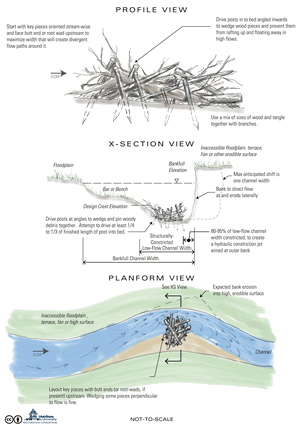Post-Assisted Log Structures (PALS)
 There are a large number of ways to construct wood jams to promote the process of wood accumulation in rivers. Posts are not always necessary as in many systems you can temporarily anchor or wedge wood between existing features like roots, boulders, existing woody debris, trees and vegetation. In other systems, you can create accumulations by getting a few “Velcro” pieces wedged in place, and seeding other wood to float in and accumulate in real time. Ultimately the natural process of wood accumulating and structurally-forcing deposition that both act to secure wood in place.
There are a large number of ways to construct wood jams to promote the process of wood accumulation in rivers. Posts are not always necessary as in many systems you can temporarily anchor or wedge wood between existing features like roots, boulders, existing woody debris, trees and vegetation. In other systems, you can create accumulations by getting a few “Velcro” pieces wedged in place, and seeding other wood to float in and accumulate in real time. Ultimately the natural process of wood accumulating and structurally-forcing deposition that both act to secure wood in place.
Post-Assisted Log Structures use a technique that has been existence for centuries of using vertically driven posts through the log structure to temporarily secure the wood in place (i.e., keep it from floating away immediately or in the first higher flow event). Unlike cabling or over-constructing a structure so the wood in it will not ever move, we simply use untreated wooden posts (e.g. peeler cores, wooden fence posts, arborist stakes - see Chapter 6 and Figure 6.4 for options). An example of a bank-attached post-assisted log structure placed to shunt flow against an erodible bank is shown at right (Figure 4.24 ). In Chapter 4’s Appdendix D we explain different PALS recipes (figure downloads below).
We encourage practitioners to experiment with different recipes and ingredients, but to adhere to the LTPBR Restoration Principles in doing so. Chapter 4 discusses PALS in more detail, whereas Module 5E the Construction of BDAs are discussed.
Recipes
Appendix D - Typical Schematics and General Suggestions for Placement and Construction of PALS
All of the figures and recipes in Appendix E of Chapter 4 are downloadable and citable with DOI: 10.6084/m9.figshare.14445564.v1


 Chapter 4: PALS & BDAs
Chapter 4: PALS & BDAs
